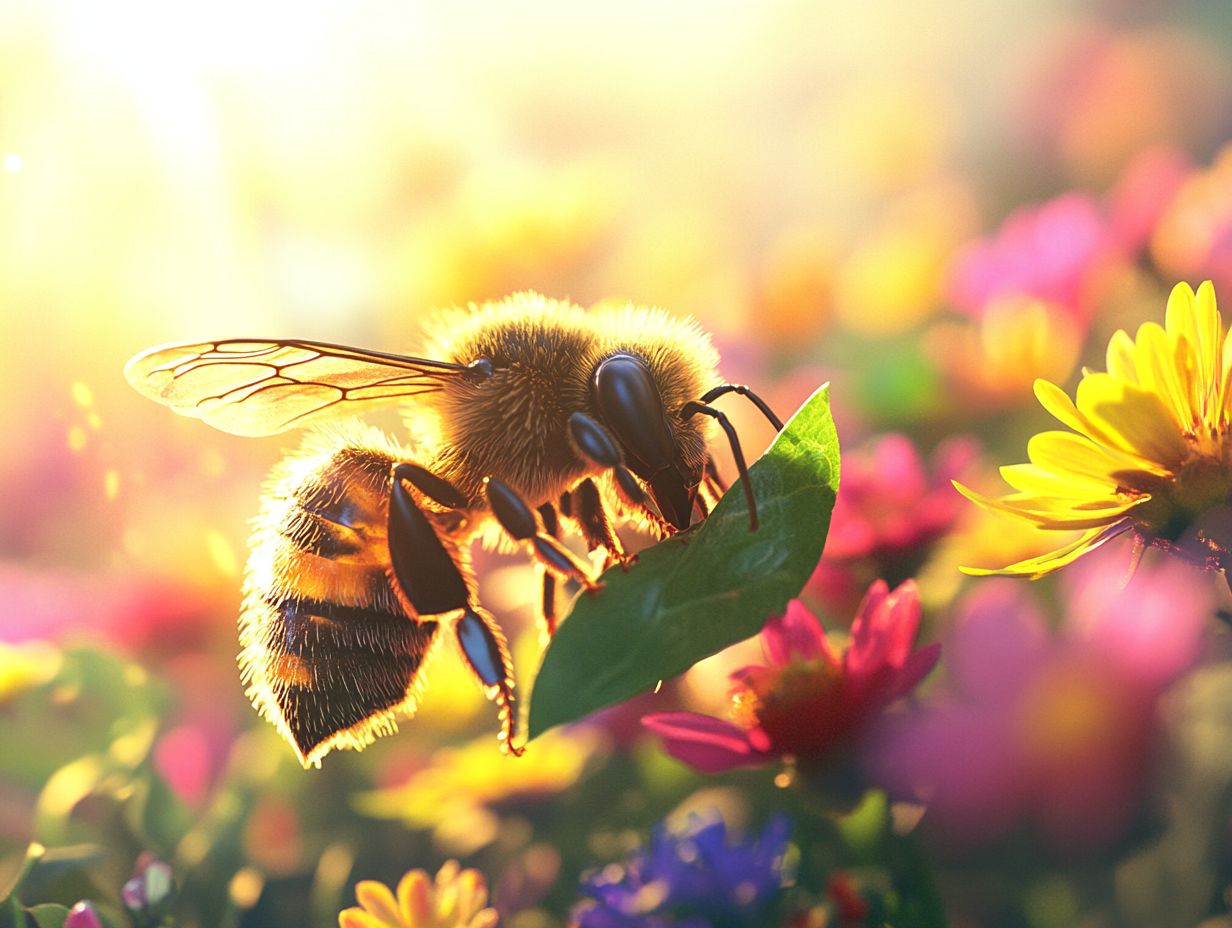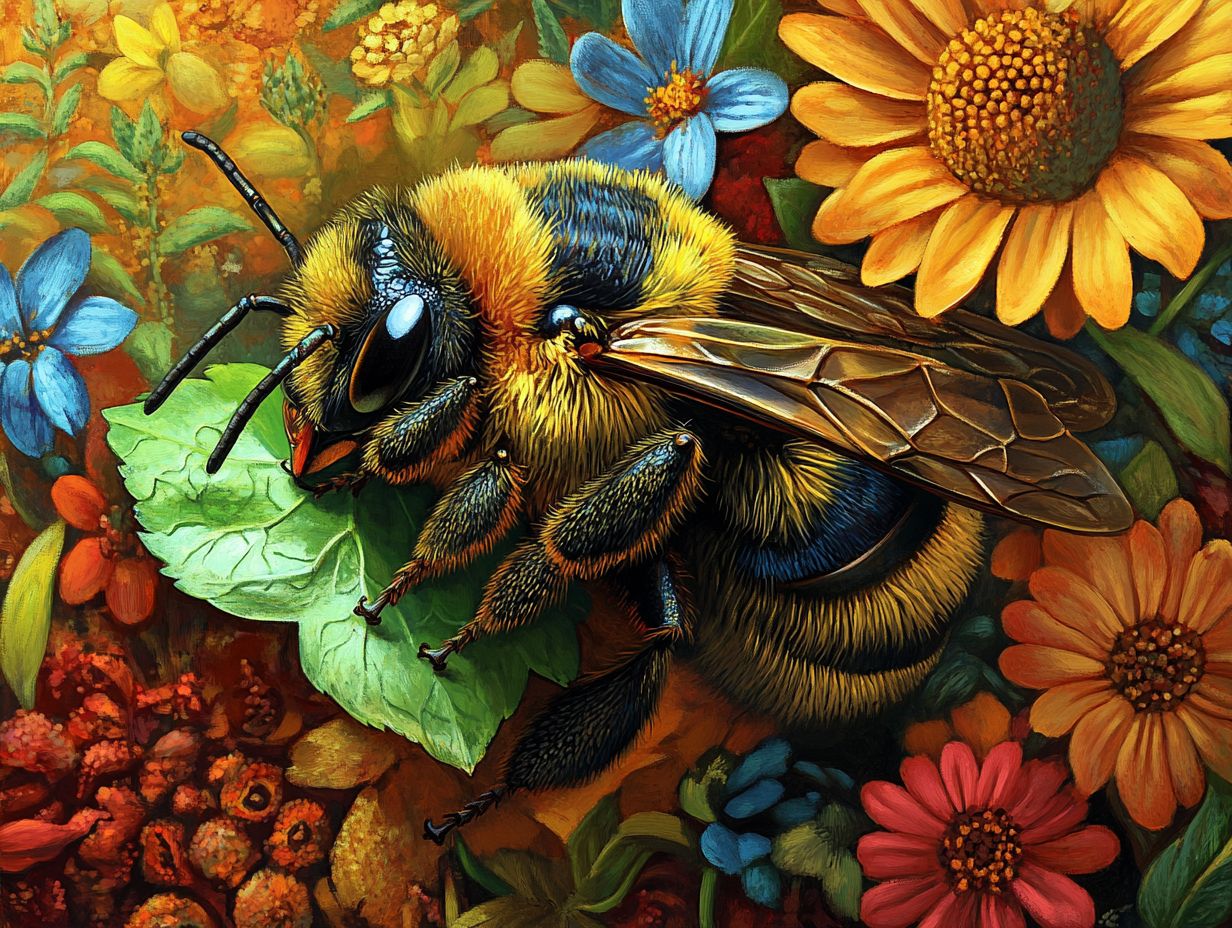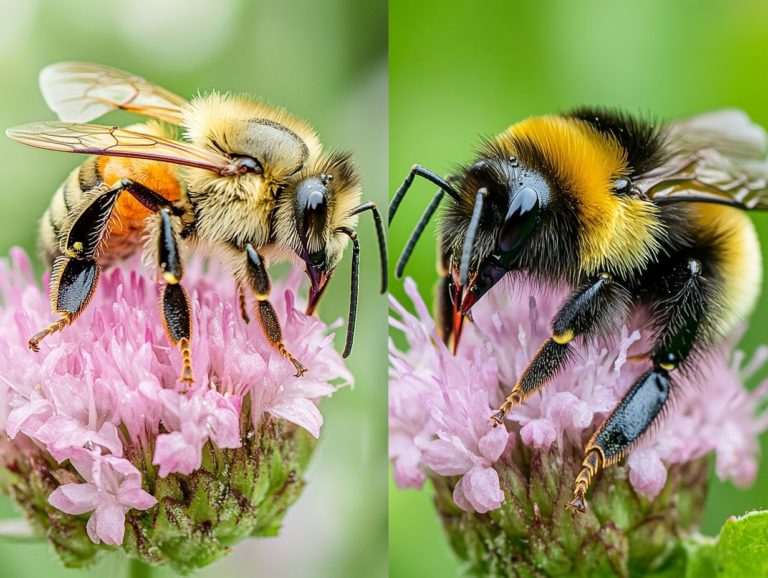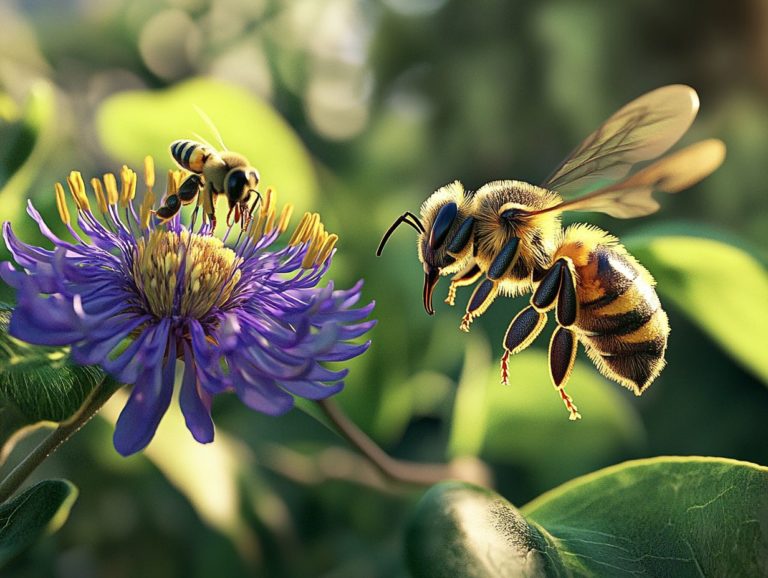Exploring the World of Leafcutter Bees
Leafcutter bees, also known as Megachile, are truly fascinating pollinators. They are celebrated for their distinctive nesting habits and their vital role in our ecosystems. Join us on an exciting journey to discover the amazing world of leafcutter bees and find out how you can make a difference!
In this exploration, you will discover their life cycle, reproduction, and feeding behaviors. You will also gain insight into how they contribute to both pollination and agriculture. The article delves into the threats these remarkable bees encounter, such as pesticide exposure and habitat loss, including the impacts of climate change. Additionally, it outlines practical steps that you, as an individual or conservationist, can take to help protect them.
Embark on this journey to uncover the significance of leafcutter bees and learn how you can actively support their survival.
Contents
- Key Takeaways:
- What are Leafcutter Bees?
- What is the Life Cycle of Leafcutter Bees?
- What Do Leafcutter Bees Eat?
- What are the Benefits of Leafcutter Bees?
- What are the Threats to Leafcutter Bees?
- How Can We Help Leafcutter Bees (Megachile)?
- Frequently Asked Questions
- Discover the Amazing World of Leafcutter Bees!
- How Do Leafcutter Bees Get Their Name?
- What Do Leafcutter Bees Eat and How Do They Support Agriculture?
- How Do Leafcutter Bees Reproduce and What is Their Life Cycle?
- Are Leafcutter Bees Beneficial to the Environment?
- Can You Attract Leafcutter Bees to Your Garden?
Key Takeaways:

- Leafcutter bees are solitary bees that create nests using leaves and petals instead of wax.
- They are important pollinators for various crops and plants, making them crucial to agriculture and the ecosystem.
- Threats like pesticide use and habitat loss endanger leafcutter bees, but individuals can help by creating bee-friendly environments, such as bee hotels, and supporting conservation efforts.
What are Leafcutter Bees?
Leafcutter bees, part of the Megachilidae family, are truly captivating solitary insects. They are known for their remarkable ability to cut leaves and petals to build their nests. These garden visitors are observed foraging on a variety of plant species. These industrious bees are not just charming garden guests; they play a vital role in pollination, making them essential for agricultural success, particularly in areas like Wisconsin.
As they forage, they primarily feast on nectar the sweet liquid produced by flowers and pollen from a variety of plant species. This ensures a steady supply of nourishment for their larvae within the egg chamber of their nests. This energy-consuming task is essential for their survival. This extraordinary behavior sustains their life cycle and significantly boosts local ecosystems and agriculture, especially for crops such as alfalfa, blueberries, and canola.
What is the Life Cycle of Leafcutter Bees?
The life cycle of leafcutter bees unfolds in several intriguing stages. It begins with the female bee carefully laying her eggs in a carefully made egg chamber, which she fills with a nutrient-rich blend of nectar and pollen designed to nourish the developing larvae.
Following an incubation period in early summer, the eggs hatch, giving rise to larvae that will undergo multiple molts before ultimately transforming into adult bees. This adult emergence marks a significant phase in their life cycle.
How Do Leafcutter Bees Reproduce?
Leafcutter bees engage in a captivating reproductive process that begins when the female searches for the perfect nesting site. She typically opts for natural bolt holes or the cozy spaces offered by bee hotels, which are artificial nesting sites for solitary bees, where she can lay her eggs in a carefully built egg chamber.
Once she identifies a suitable location, she carefully builds the egg chamber using freshly cut leaf pieces. These leaves serve as a vital source of nutrition for the larvae as they develop. In contrast, males adopt a more opportunistic approach, often dispersing over large areas to maximize their chances of encountering receptive females.
After mating, females possess the remarkable ability to store sperm and selectively fertilize their eggs, showcasing a sophisticated reproductive strategy. This method promotes genetic diversity and allows them to maintain their solitary lifestyle.
Their solitary habits play a crucial role in their population dynamics, enabling them to adapt and thrive in various environments while navigating the challenges posed by habitat loss and environmental changes.
What is the Nesting Behavior of Leafcutter Bees?
The nesting behavior of leafcutter bees is truly fascinating. These solitary insects carefully gather nesting materials, primarily leaves and petals, to construct places for their eggs within various substrates, including soft wood or hollow stems.
You ll find that these industrious pollinators often seek out nesting locations that shield them from predators and the elements. They prefer sites such as decaying logs, plant stems, and crevices in buildings or wooden doors. The choice of a nesting site is crucial to their survival, providing a safe haven for their larvae while significantly influencing their reproductive success and community impact.
By opting for optimal locations, leafcutter bees can ensure a higher rate of egg hatching and better access to food resources. This behavior also benefits the local ecosystem, as these bees play a vital role in plant pollination, contributing to enhanced biodiversity within their community and local agriculture.
What Do Leafcutter Bees Eat?

Leafcutter bees primarily feed on:
- Nectar
- Pollen
These serve as vital energy sources that fuel their foraging and reproductive endeavors. This makes them critical contributors to the pollination of a diverse array of garden plants and crops.
What are the Benefits of Leafcutter Bees?
Leafcutter bees bring countless benefits to your garden and the environment! They serve as essential agricultural pollinators, significantly enhancing crop pollination and bolstering the health of garden plants through their diligent foraging activities.
Embracing the presence of these remarkable bees in your garden can lead to a thriving environment and bountiful harvests.
How Do Leafcutter Bees Help with Pollination?
Leafcutter bees are essential pollinators that remarkably enhance pollination efficiency in your garden plants and agricultural crops, ensuring healthy yields and vibrant ecosystems.
These small yet industrious insects exhibit a fascinating behavior of cutting circular pieces from leaves and petals to construct their nests, showcasing their unique adaptations. They prefer flowering plants that provide ample nectar and pollen, often favoring species like clover, alfalfa, canola, and various wildflowers.
As they forage, leafcutter bees diligently transfer pollen from one bloom to another, playing a critical role in supporting plant reproduction and promoting biodiversity in their habitats. Their activities also benefit other pollinators like the honey bee and bumble bee. Their contributions sustain food production, benefiting both farmers and wildlife, making them critical players in the delicate balance of natural ecosystems and agricultural systems.
What Role Do Leafcutter Bees Play in Agriculture?
In agriculture, leafcutter bees play an essential role as highly effective pollinators, especially for crops like alfalfa and blueberries. Their contribution significantly enhances both the quality and quantity of your yields.
These industrious insects do more than just ensure better fruit set; they also bolster the stability of entire agricultural systems by increasing crop resilience against pests and diseases. As a farmer, it s becoming increasingly clear how much you depend on these pollinators, as many of your crops rely heavily on insect pollination to achieve peak growth and production.
Providing bee hotels or typical bolt holes can create a vital habitat for leafcutter bees, offering safe nesting sites that encourage their populations to flourish. By implementing such initiatives, you can actively participate in sustaining these beneficial pollinators, ultimately fostering greater agricultural productivity and promoting ecological balance.
What are the Threats to Leafcutter Bees?
Leafcutter bees encounter a multitude of challenges that threaten their existence. These include biological threats from agents like Pteromalus venustus and diseases like Chalkbrood. The pervasive use of pesticides and habitat loss from urban expansion pose significant risks to their populations.
The impacts of climate change further jeopardize their nesting sites, making it increasingly vital to recognize and address these concerns. Immediate action is needed to protect their habitats and ensure their survival.
How Do Pesticides Affect Leafcutter Bees?

Pesticides pose a serious threat to leafcutter bees by affecting their health and foraging behaviors. This ultimately leads to concerning population declines.
Certain neonicotinoids a type of pesticide that harms bees and pyrethroids are particularly troublesome. They disrupt nerve communication and impair foraging abilities. When leafcutter bees are exposed to these chemicals, they may struggle to recognize floral cues, which are crucial for their role in pollination.
This exposure can induce physiological stress, diminishing their overall vitality and affecting the colony’s reproductive output. Research from the 1980s by entomologist Charlotte Rankin and studies from BugLady highlight these impacts.
The decline of these essential pollinators also jeopardizes the stability of local ecosystems. It poses a substantial risk to agriculture since many crops depend heavily on effective pollination. A drop in leafcutter bee populations can lead to lower yields and decreased biodiversity, underscoring the urgent need for sustainable practices in pesticide usage.
What Other Factors Contribute to the Decline of Leafcutter Bees?
Along with pesticide exposure, habitat loss and climate change significantly contribute to the decline of leafcutter bees. These factors disrupt their nesting sites and food sources.
These threats not only impact the bees directly but also ripple through the agricultural landscape. They affect crop pollination and ultimately food production and overall agricultural output. Urban development often reduces wildflower habitats that are essential for these vital pollinators.
As climatic patterns shift, changes in temperature and precipitation can alter the delicate synchronization between flowering plants and the bees. This makes it increasingly challenging for these diligent pollinators to thrive.
The decline can trigger a cascading effect within local ecosystems, jeopardizing your community s efforts to support sustainable agriculture, crop pollination, and plant species diversity.
How Can We Help Leafcutter Bees (Megachile)?
Supporting leafcutter bees (Megachile) is essential for their survival. You have a remarkable opportunity to make a difference! There are several effective ways you and your community can contribute, such as creating bee hotels and championing conservation initiatives that support agricultural pollinators.
Taking these steps not only helps the bees but also fosters a healthier ecosystem for everyone. Join us in protecting these precious pollinators!
What Can Individuals Do to Support Leafcutter Bees?
You have the power to make a real difference! One way to support leafcutter bees is by embracing bee-friendly gardening practices and installing bee hotels to create welcoming nesting opportunities.
Planting native flowers in your garden is a fantastic way to attract leafcutter bees and help them thrive! These plants thrive in your local environment and are particularly attractive to these vital pollinators.
It s equally important to avoid pesticides; these harmful chemicals can deter or even eliminate beneficial insects that are crucial to your garden’s health. Correctly setting up bee hotels is also key; place them in a sunny spot near wooden doors or typical bolt holes and shield them from rain to ensure a suitable habitat.
Community engagement is paramount; collaborating with your neighbors to restore habitats can amplify your efforts. Together, you can create a network of gardens that nurtures biodiversity and bolsters local ecosystems.
Together, we can create a buzz for change and support our vital bee populations!
What Conservation Efforts are Being Made for Leafcutter Bees (Megachilidae)?
Conservation efforts to protect leafcutter bees include restoring habitats, research initiatives, and community involvement. These efforts aim to raise awareness about the vital role these pollinators play. Notable figures like Charlotte Rankin and the BugLady have been advocating for these bees since the 1980s.
By engaging local communities and implementing learning programs, organizations are developing programs that highlight the necessity of preserving the natural habitats where these bees thrive. These initiatives often emphasize the essential contribution of leafcutter bees to pollination not only for crops but also for maintaining overall biodiversity.
Addressing their habitat needs, such as accessible nesting sites and plentiful plant resources, is crucial for their survival. This is often accomplished through community planting events and workshops. It s also important to understand how larvae and adult leafcutter bees contribute to the ecosystem.
Through these collaborative efforts, you become a caretaker of nature, discovering how your actions can directly support the thriving populations of leafcutter bees. By contributing to research, such as studies conducted in Wisconsin, you also help in understanding and mitigating threats to these vital pollinators.
Frequently Asked Questions

Discover the Amazing World of Leafcutter Bees!
Leafcutter bees (Megachilidae) are a type of solitary bee found all over the world, except Antarctica. They typically reside in warm and temperate regions and prefer habitats that provide ample nesting material, such as leaves and petals, to construct their egg chambers.
How Do Leafcutter Bees Get Their Name?
Leafcutter bees get their name from their unique behavior of cutting and collecting circular pieces of leaves to make their nests. These bees are skilled leaf cutters and can create perfectly round pieces of leaves for their homes.
What Do Leafcutter Bees Eat and How Do They Support Agriculture?
Leafcutter bees primarily feed on nectar and pollen from flowers, just like honey bees and bumble bees. They play a crucial role in pollination and are important for many crops and plants, including alfalfa, blueberries, and canola.
How Do Leafcutter Bees Reproduce and What is Their Life Cycle?
Leafcutter bees are solitary bees, meaning they do not live in colonies like honeybees. Females create individual nests consisting of several cells, where they lay their eggs and provide food for their offspring. Males locate these nests to mate with the females. Collecting leaf pieces to construct their nests is mainly done in early summer.
Are Leafcutter Bees Beneficial to the Environment?
Yes, leafcutter bees are highly beneficial to the environment. They play a vital role in pollination, aid in controlling pests, and promote biodiversity. They are important food sources for other animals, such as birds and spiders, and their presence enhances the local ecosystem.
Can You Attract Leafcutter Bees to Your Garden?
Yes, you can attract leafcutter bees to your garden by providing suitable nesting sites and a variety of flowering plants. You can also purchase leafcutter bee houses to encourage them to nest in your garden. Placing these bee hotels in areas with abundant garden visitors and ensuring the availability of nectar and pollen will significantly increase their chances of thriving.
Join us in making a difference for these essential pollinators today!






